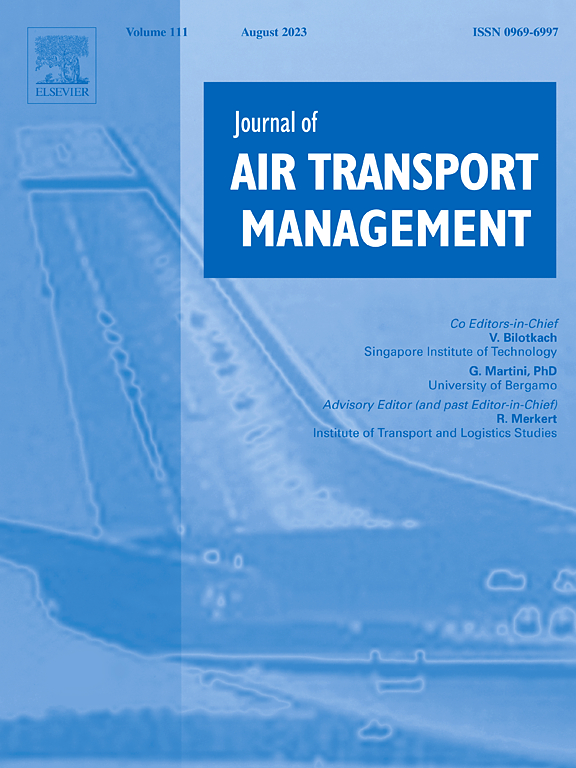基于电池充电和更换的电动和燃油飞机调度优化问题——以中国航班为例
IF 3.6
2区 工程技术
Q2 TRANSPORTATION
引用次数: 0
摘要
在电气化的趋势下,民航正在推广电动飞机,以减少排放。近年来,技术进步为在航线上使用电动飞机提供了可能性。本文将探讨电动飞机和燃油飞机的调度问题。在当前绿色发展的状态下,电动飞机和燃油飞机的混合运营模式是必要的,因为电动飞机目前面临着长途航线运营商的重大挑战。同时,电池交换技术可以显著缩短飞机在机场的充电时间。为此,本文研究了考虑电池充电和换电的燃油飞机调度优化问题。为了使总排放、充电、交换和延迟成本最小化,我们引入了一个混合整数规划公式。模型的约束考虑了流量、充电和时间约束。我们提出了m参数边界和两个有效的模型增强不等式。国航的案例研究展示了实际的见解。结果表明,电动飞机数量和电池容量的增加导致排放成本的降低和延误成本的增加。电动飞机和燃油飞机是互补的。有些长途航线不能由电动飞机执飞,但可以由燃油飞机执飞。同时,燃油飞机也有助于降低延误成本。同时,更广泛地部署电池更换站可以减少延误,提高乘客满意度。本文章由计算机程序翻译,如有差异,请以英文原文为准。
Electric and fuel aircraft schedule optimizing problem with battery charging and swapping — The case of flight in china
Under the trend of electrification, civil aviation is promoting electric aircraft to reduce emissions. In recent years, technological advancements have opened up the possibility of employing electric aircraft in flight routes. This paper will explore the scheduling problem of electric and fuel aircraft. The mixed operation mode of electric and fuel aircraft is necessary in the current state of green development since electric aircraft currently face significant challenges for operators of long haul routes. Meanwhile, the battery swapping technology can significantly reduce aircraft charging time at airports. Therefore, this paper investigates the optimization problem of the electric and fuel aircraft schedule with battery charging and swapping (ef-ASOP). We introduce a mixed integer programming formulation for the ef-ASOP to minimize total emission, charging, swapping and delay costs. The constraints of the model consider flow, charging and time constraints. We propose M-parameters bounds and two valid inequalities for model enhancement. The Air China case study demonstrates practical insights. The results show that an increase in the number of electric aircraft and battery capacity leads to a reduction in emission costs and an increase in delay costs. Electric aircraft and fuel aircraft are complementary. Some long haul routes cannot be operated by electric aircraft, but can be met by fuel aircraft. At the same time, fuel aircraft also help reduce delay costs. Meanwhile, more widespread deployment of battery swapping stations can reduce delays and improve passenger satisfaction.
求助全文
通过发布文献求助,成功后即可免费获取论文全文。
去求助
来源期刊

Journal of Air Transport Management
TRANSPORTATION-
CiteScore
12.40
自引率
11.70%
发文量
97
期刊介绍:
The Journal of Air Transport Management (JATM) sets out to address, through high quality research articles and authoritative commentary, the major economic, management and policy issues facing the air transport industry today. It offers practitioners and academics an international and dynamic forum for analysis and discussion of these issues, linking research and practice and stimulating interaction between the two. The refereed papers in the journal cover all the major sectors of the industry (airlines, airports, air traffic management) as well as related areas such as tourism management and logistics. Papers are blind reviewed, normally by two referees, chosen for their specialist knowledge. The journal provides independent, original and rigorous analysis in the areas of: • Policy, regulation and law • Strategy • Operations • Marketing • Economics and finance • Sustainability
 求助内容:
求助内容: 应助结果提醒方式:
应助结果提醒方式:


